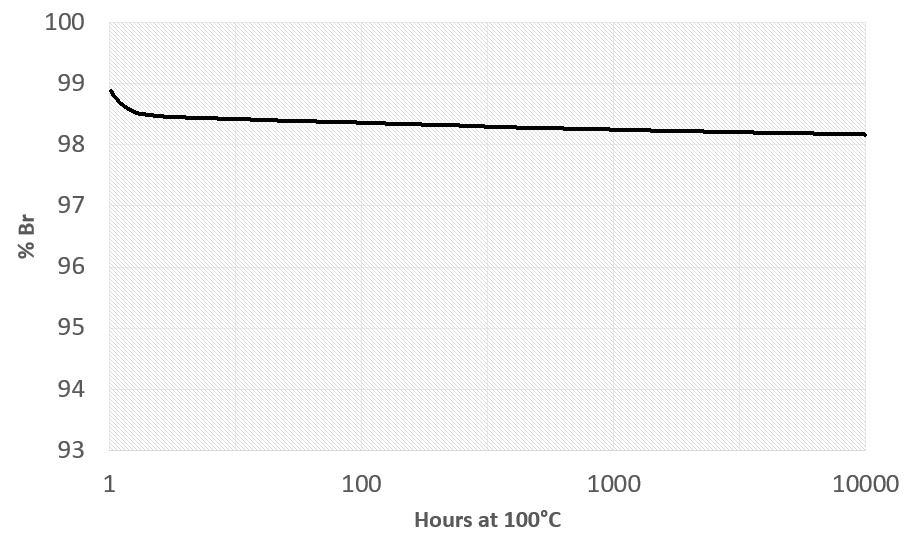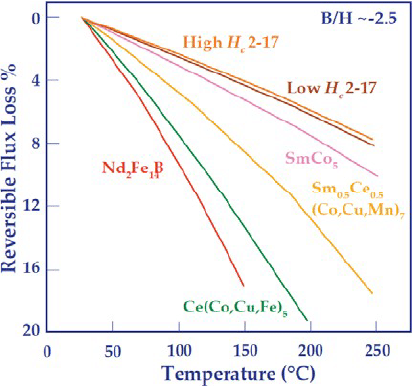
One of the most common questions we are asked is whether the permanent magnets that we supply lose their magnetism over time. It is easy to simply say ‘no’, but what is the science?
The range of permanent magnets includes ferrite (ceramic), neodymium (Rare Earth), samarium cobalt (Rare Earth), and AlNiCo. All have different properties that make them more suitable for specific applications. For example, a ferrite (ceramic) magnet is weaker but less expensive than a neodymium magnet.
The effect of time on modern permanent magnets in minimal. Magnets will see changes immediately after magnetisation, which are known as ‘magnetic creep’. These occur as less stable domains are affected by fluctuations in thermal of magnetic energy, even in a thermally stable environment. This variation reduces as the number of unstable domains decreases. Rare Earth magnets are less likely to experience this effect because of their high Coercivity.
In terms of time, studies have shown that a newly magnetised magnet will lose only a minor percentage of its flux as a function of age (e.g. 1% in 100 years).

However, other factors that affect demagnetisation of permanent magnets include exposure to other external forces (e.g heat, physical damage, etc). So what happens then?
How Physical Damage Affects Magnetism
Physical damage relates to a magnet experiencing an external sudden force such as being dropped or struck. Even if the magnet does not break, it is likely that the magnetic flux will be adversely affected. In addition repeated shocks can cause continuous damage to a magnet and typically magnets used as caps or covers that are regularly removed are specified at double their minimum strength as 50% of the performance of magnet is typically lost on a magnet that is repeatedly shocked over the life of a product.
How Temperature Affects Magnetism
The most common cause for a loss in magnetic flux is temperature variation beyond its specification, mostly an increase in temperature but some magnets suffer more when cooled.
Typically though, when a magnet is subjected to heat, there is a fall in magnetic performance. Each type of permanent magnet behaves differently, with some magnets having a greater tolerance to increasing temperatures. The table shows the typical maximum working temperature for the most common permanent magnets, below which all the changes in performance are reversible.

Despite the loss in magnetic flux in a rising temperature environment, there are losses that are recovered when the magnet returns to the original temperature. These are known as ‘Reversible Losses’. These losses vary for different magnet materials and are not always linear as the temperature increases.
However, once a certain temperature limit has been exceeded, the magnet material will fail to cover to its original strength once returning to the original temperature. For magnets to completely lose their magnetism they must be exposed to their Curie temperature, which is significantly higher than their recommended operating temperatures.
Selecting the Optimal Magnet Material
Understanding the operational environment dictates the optimal magnet material. Bunting’s applications engineering team work with designers to understand the operational scope of any magnet material. If the requirement is for the magnet material to operate in excessively high temperatures, then Samarium Cobalt (SmCo) or even the AlNiCo magnet may be recommended despite AlNiCo having a lower magnetic flux at normal temperatures.
If in doubt, then we always recommend speaking with our experienced team who can provide support and advice.
Related Technical Articles
Bunting designs and manufactures a wide range of magnets and magnetic assemblies. Many are bespoke for specific applications. For further information on any of the products mentioned in this review, or for bespoke magnet assemblies and magnet designs, please contact us via:
Phone: +44 (0) 1442 875081
Email: eMagnets@buntingmagnetics.com
Via Bunting-eMagnets for online purchase of Magnets and Magnetic Technology
